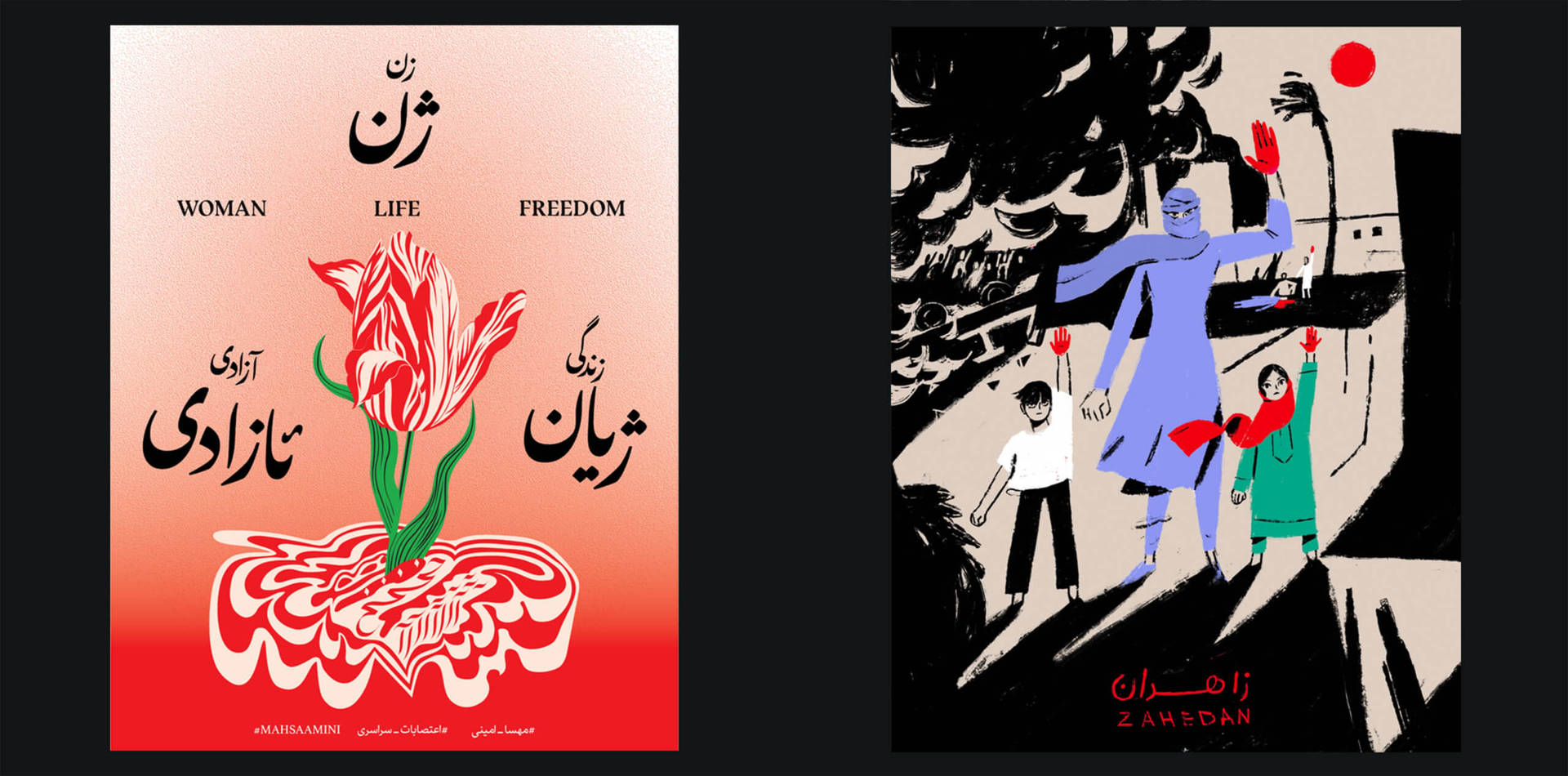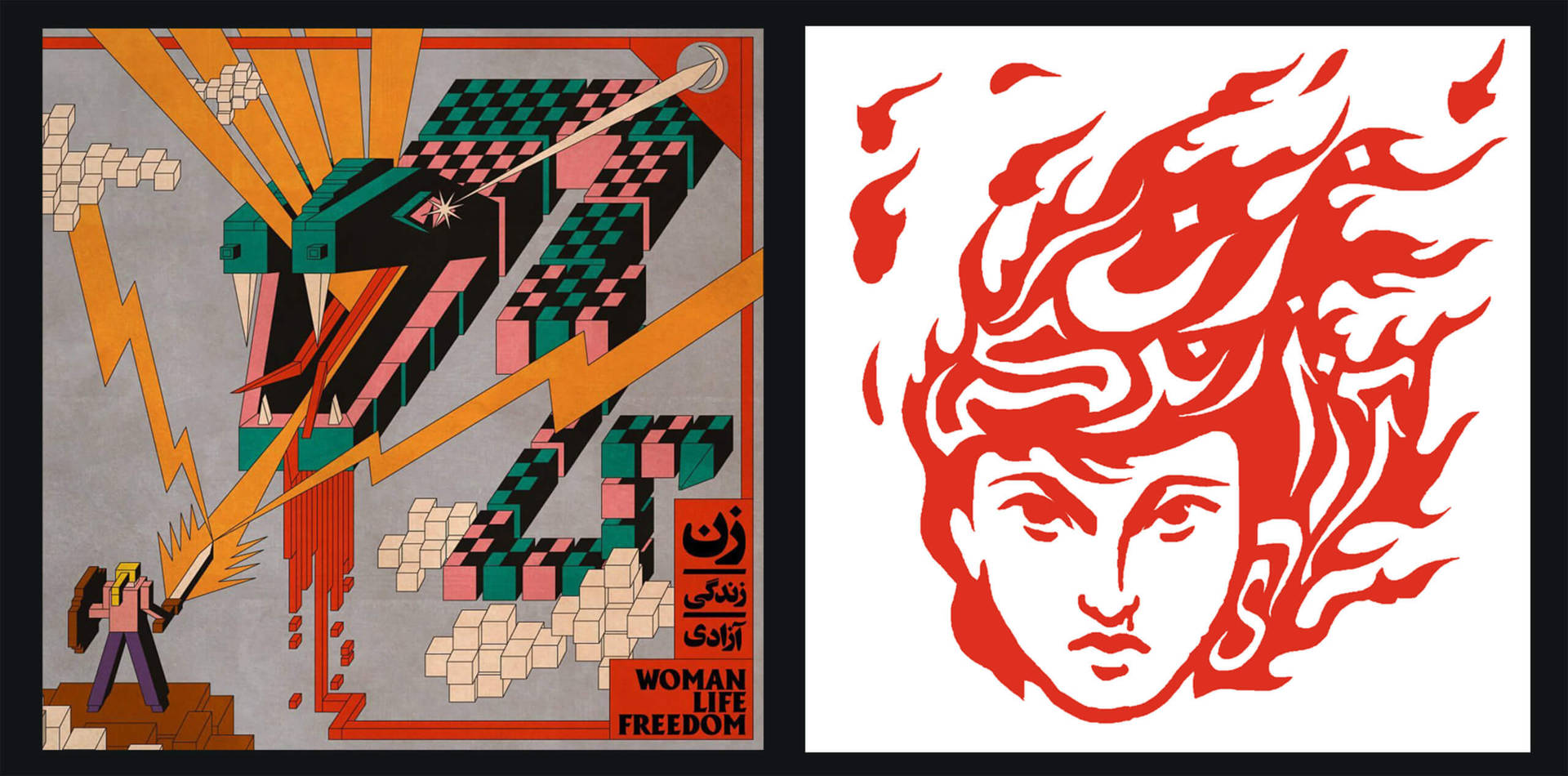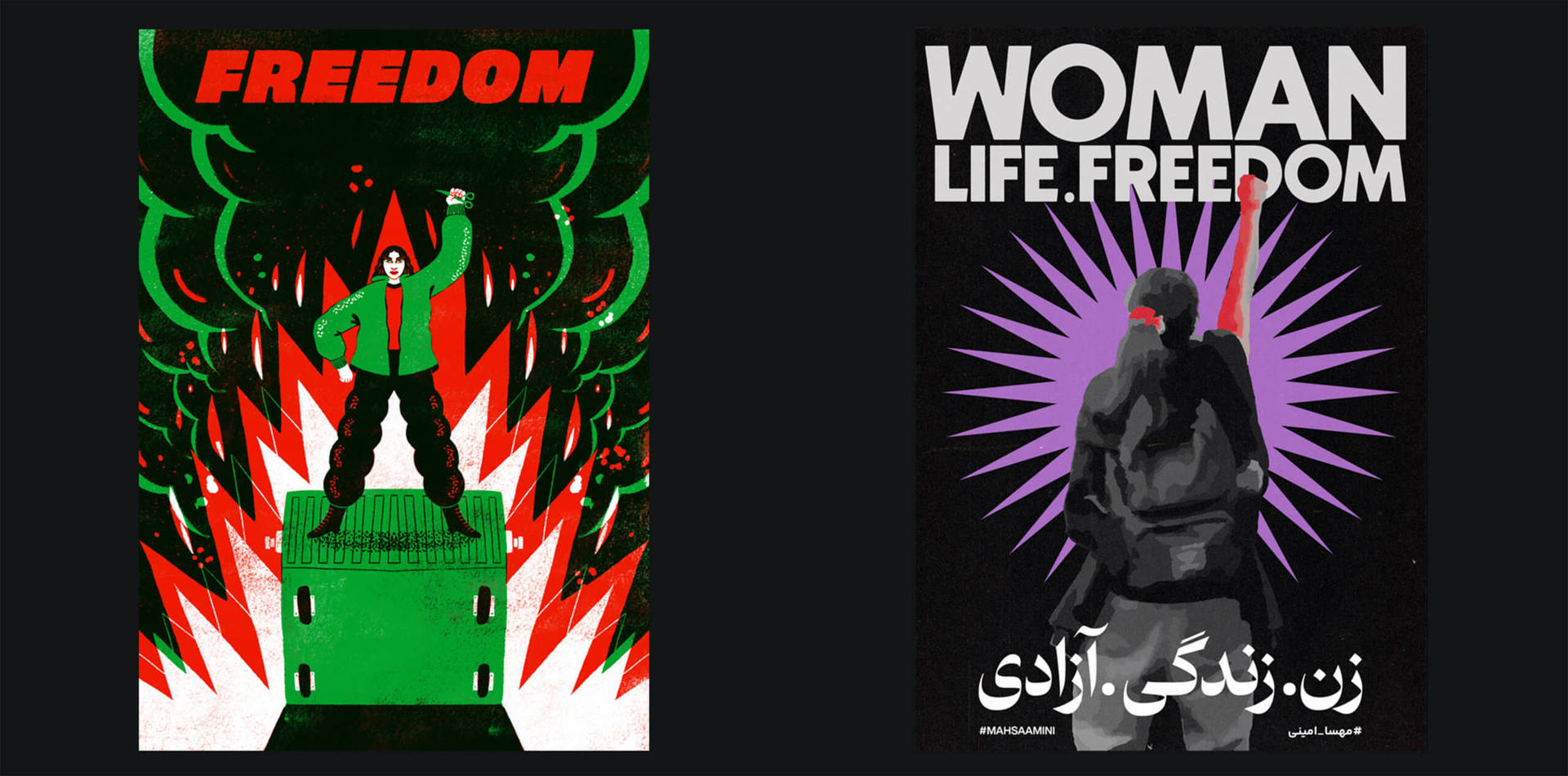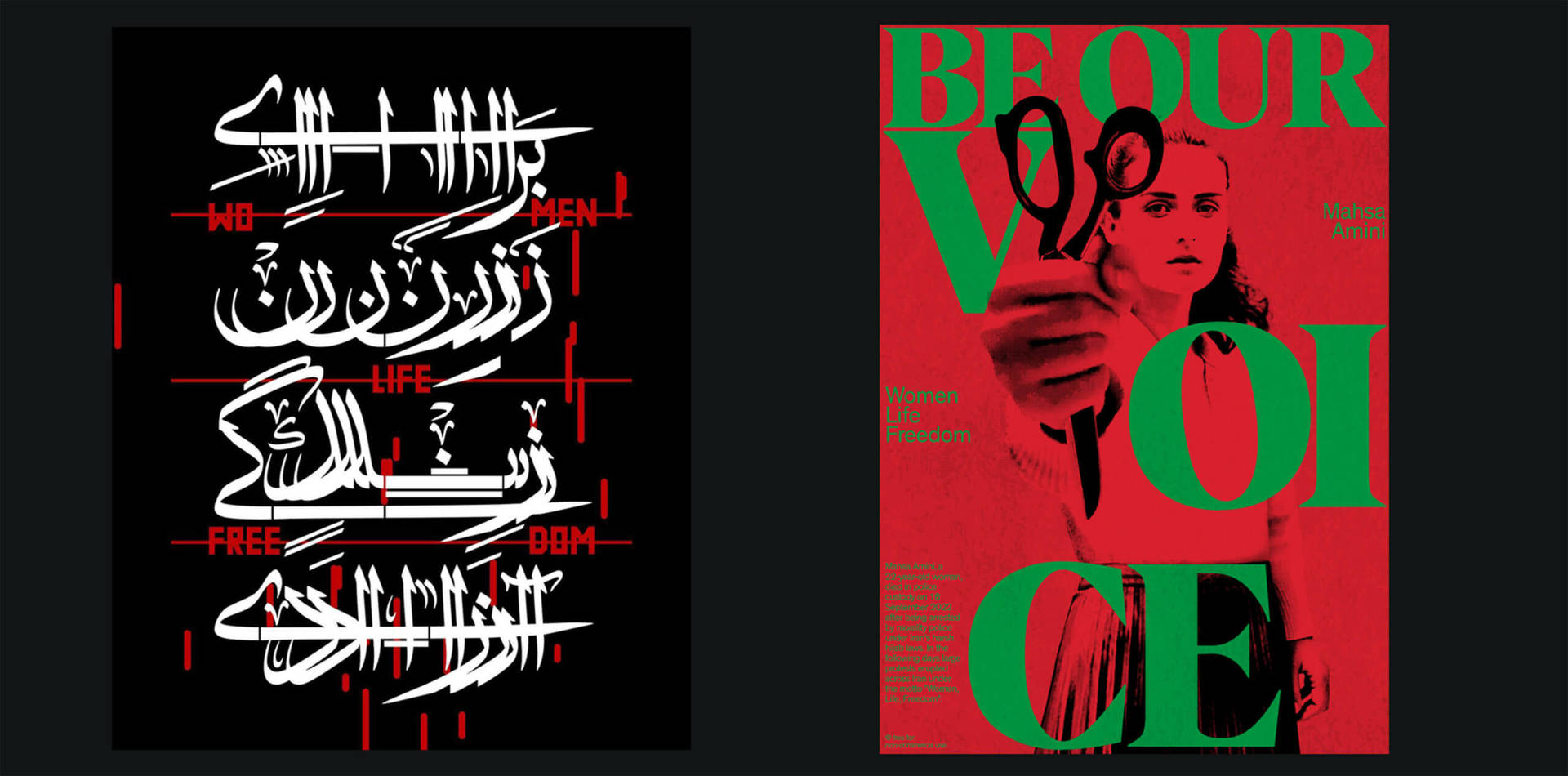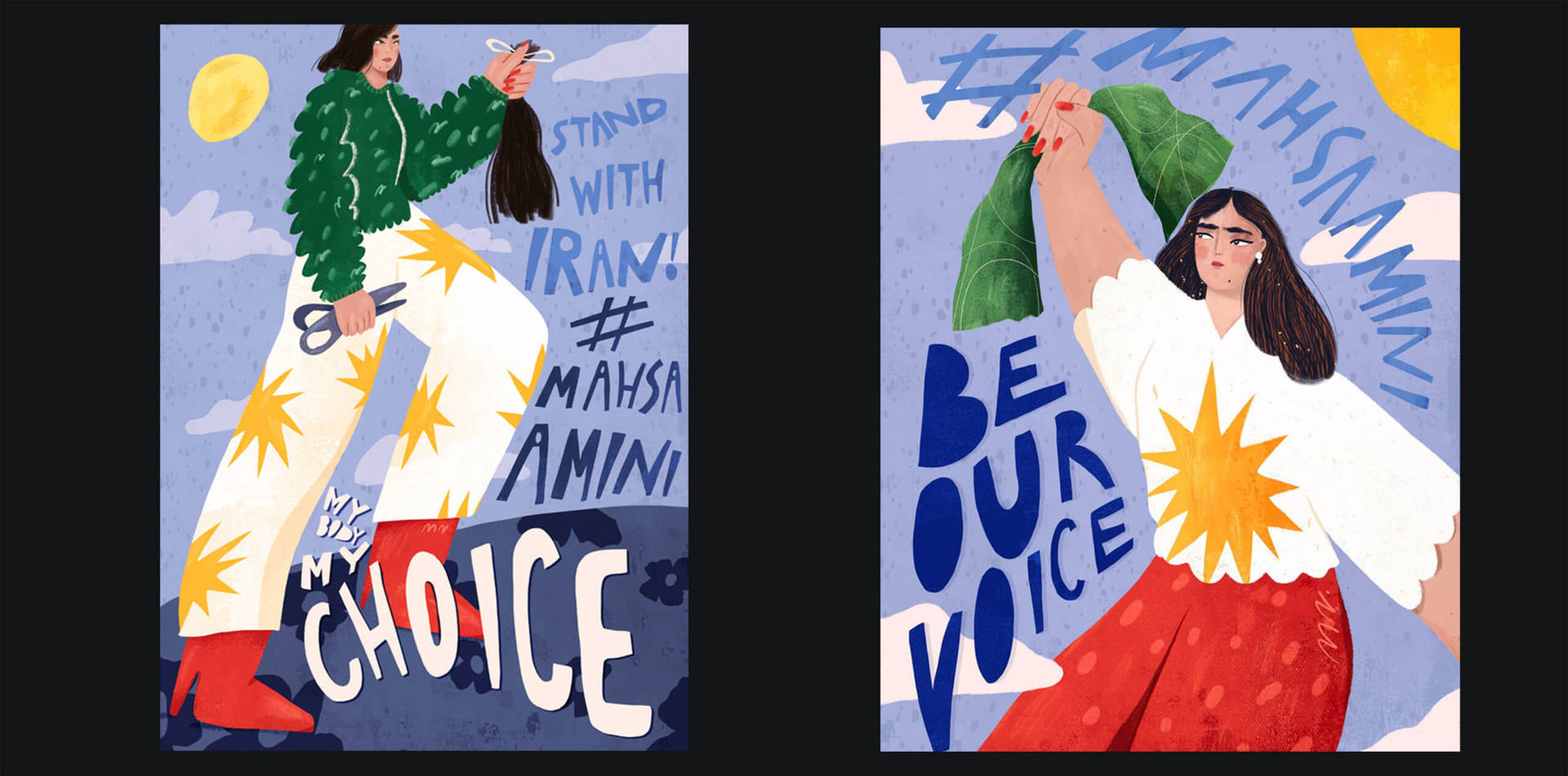Platform ‘Iranian Women of Graphic Design’ share open-access protest posters to amplify #WomenLifeFreedom movement—triggered by the death of Mahsa Amini—in Iran and beyond.
Mahsa Amini, a 22-year-old Kurdish woman, died in hospital three days after being arrested by the morality police in Tehran on 16 September 2022. Witnesses reported that she was beaten while in custody and in response to her death, protests have erupted across Iran and in many parts of the world, with #WomenLifeFreedom becoming the rallying cry of the movement.
Iranian Women Of Graphic Design started life as a platform for Iranian women designers in and outside of Iran to showcase their work due to a lack of representation in the field. When protests started in Iran after the tragic death of Mahsa Amini, the platform was inundated with works centring on #WomenLifeFreedom movement and they decided to evolve into a protest platform.
The platform now features graphics by Iranian and non-Iranian designers who have submitted their work for use in the protests. ‘It allows us to amplify the voice of the protesters while the regime suppresses the voice of the people by blocking the internet,’ Iranian Women of Graphic Design tells DbyW. Serving as both documentation and a form of communication to facilitate the protests, it is crucial that the posters continue to be shared and used. As they tell us: “Posters work both, in the streets and on social media. They are the visual memory and an archive of this movement. They tell stories of struggle, of resistance, and of the timeliness of the issues represented.”
The posters are available for download from this database.
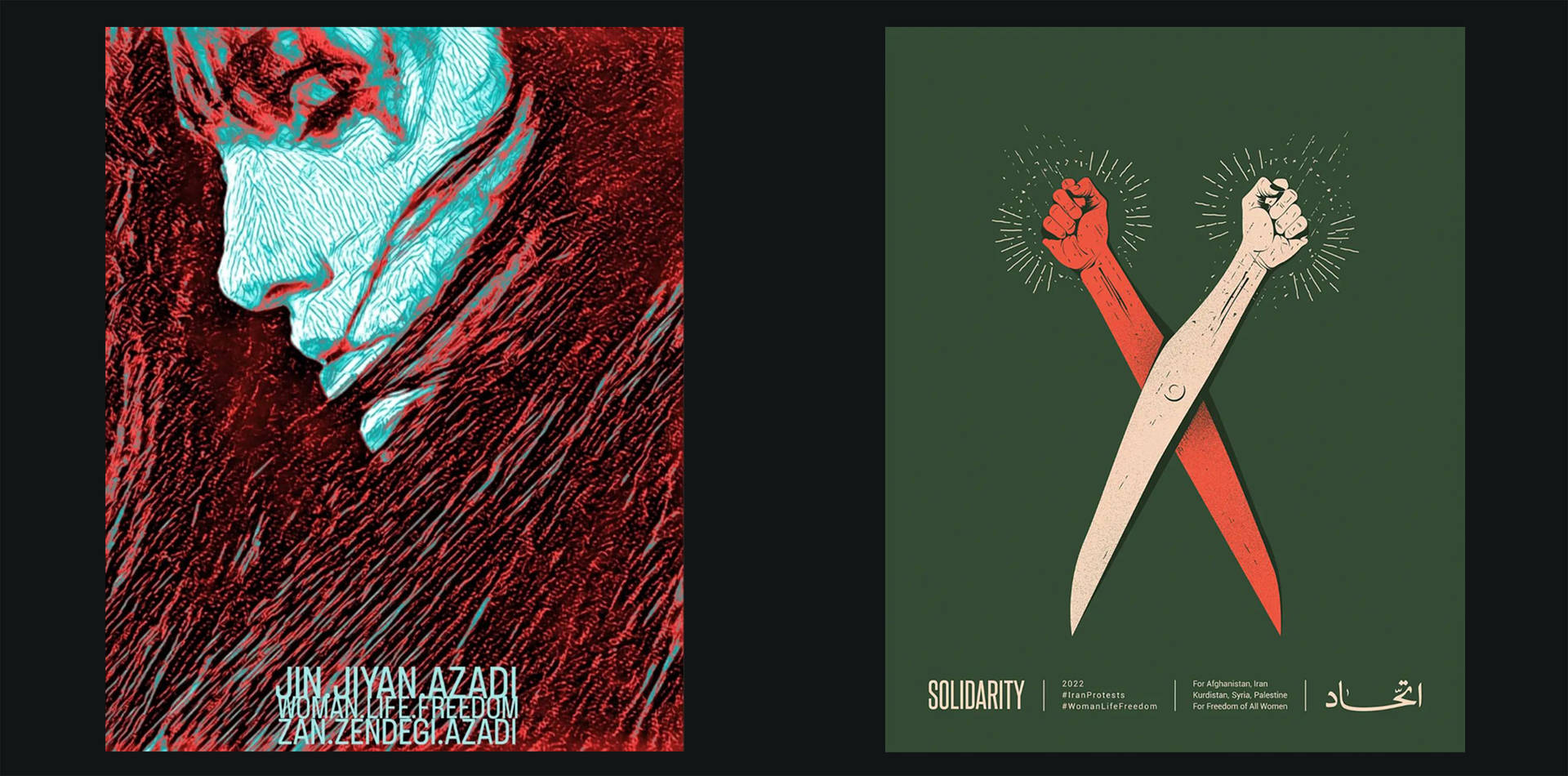
We talked with Iranian Women of Graphic Design to find out more about why they started the platform, why sharing protest poster is important and how we can support the #WomenLifeFreedom movement by amplifying the voices of people in Iran.
Why did you start the platform Iranian Women of Graphic Design?
‘Iranian Women of Graphic Design’ started as an initiative to address the low visibility and representation of female graphic designers in the state-regulated cultural sector in Iran. The idea was born after a book was published in Teheran titled 100 Years of Iranian Graphic Design History which included works by 100 designers, of which only 5 were women. The book triggered discussions about women in graphic design and other art disciplines as well as the founding of @IranianWomenofGraphicDesign. @IranianWomenofGraphicDesign started in the fall of 2020 and within just a few hours of its launch over 100 works by women designers were published from a private archive, which highlighted the systematic oppression of women by the state publishers.
From the beginning, it was very important for us to show works by Iranian women inside and outside Iran and from different backgrounds (different generations, faiths, design schools). In order to diversify the collection, we also contacted young female designers and encouraged them to show their works. We worked like this until two months ago.
Since the protests sparked by the death of Jina Mahsa Amini and the #WomanLifeFreedom movement began we not only share work designed by women on diverse issues, but also work designed by diverse people for women. What connects @IranianWomenofGraphicDesign with #WomenLifeFreedom is the shared fight against the oppression of women and the violation of their rights and for equal justice and freedom. Naturally, the current movement fights for these things on a much larger scale and in social, cultural, political and other fields. Our page now hosts protest posters and offers demonstrators materials to fight against the regime.
“What connects @IranianWomenofGraphicDesign with #WomenLifeFreedom is the shared fight against the oppression of women and the violation of their rights and for equal justice and freedom.”
Image Credits – Left: @vvorkvvorkvvork Right: Akram Esmaili @akramesmailli
How has the platform evolved since the death of Mahsa Amini?
We have always received work on various themes. However, in the first days of this protest, we received more posters with the theme #MahsaAmini and #WomenLifeFreedom, and not only from women, but also from men. The more protest posters we published, the more we were sent. And as the protests became more known around the world, we received posters from international designers. This became a social media movement without a ‘Call Out’ for works. In addition, we added works that we found through our own research.
“We have always received work on various themes. However, in the first days of this protest, we received more posters with the theme #MahsaAmini and #WomenLifeFreedom, and not only from women, but also from men.”
What is happening to protesters in Iran now?
Since the killing of Jina Mahsa Amini by the Iranian morality police, protests and strikes are currently taking place across Iran andmaking global waves. So far, several hundred people have been killed and over 14 thousand protesters have been arrested and are to be executed , according to the orders of the regime’s parliament.
For several days, access to the Internet has been blocked, a means used by the Iranian regime to suppress the protests and prevent them from reaching the public. People living outside the country are urged to continue, and to maintain protests in the streets worldwide and on the Internet.
Thousands of women and men are engaged in clashes with security forces, who are responding with bloody violence. The protesters are demanding an end to the Islamic regime and the oppression of women, in exchange for democracy and human rights.
Image Credits – Top Left: Del Hambre @soy_del_hambre Top Right: Frank Arbelo @arbelostudio — Bottom Left: Jamshid Dejagah @jamshid_dejagah Bottom Right: Anonymous designer from Tehran
Why is it important to create protest posters and share voices from the protest movement?
Posters are an effective medium of political communication in a condensed, visual form. They have the power to get people’s attention and to bring them together around a simple phrase or affective image and spread the message of resistance to power and of solidarity.
Posters work both in the streets and on social media. They are also a visual memory archive of this movement. They tell stories of struggle, of resistance, and of the timeliness of the issues represented.
Therefore, it is important for us to create and distribute posters at this moment in time. It allows us to amplify the voice of the protesters while the regime suppresses the voice of the people by blocking the internet. We want to give visibility to the people and their fight through design.
“Posters are an effective medium of political communication in a condensed, visual form. They have the power to get people’s attention and to bring them together around a simple phrase or affective image and spread the message of resistance to power and of solidarity.”
What are the recurring themes of the protest posters?
The posters reflect what is happening in the streets and document the development of the protests and the revolution, which mean the themes are constantly changing.
However, many posters and artworks depict women cutting their hair. Women cutting their hair is an ancient Persian tradition that symbolizes protest and mourning. This tradition is still maintained in some ethnic groups in Iran, such as the Kurds. After the death of Kurdish woman Mahsa “Jina” Amini, this tradition quickly spread on social media and was used as a symbol for anti-government protests in Iran and beyond.
Another theme that appears repeatedly on the posters is the burning headscarf. The headscarf is a means of oppressing women in the Islamic government. In recent days, women have taken off their headscarves and burned them in the streets to symbolically free themselves from the oppression of a patriarchal Islamic government. And of course, the main theme of the posters are female figures are, which become combined with elements like flames, the middle finger andPersian typography among others, transforming into new protest icons within a few days.
“Woman, Life, Freedom” or “Zhen, Zhian, Azadi” is a theme seen on almost all posters. This slogan was first used by Kurdish women fighting against the Islamic State (Daesh). In September this year it quickly became the main slogan of the protests after the death of Mahsa Amini, next to her name.
Image Credits – Top Left: Tania Yakunova @anni_tett Top Right: Laura Acquaviva @_laura_acquaviva_ — Bottom Left: Or Yogev @shabloolim Bottom Right: Amir Darafsheh_1 @daarafsh
What can people do to help amplify the voices of the Iranian people?
There are various ways to help the people in Iran. The most important thing is not to let the protests die down and to continue to draw attention to the conditions online as well as offline. This plays a particularly strong role when people on the ground no longer have options to draw attention to their situation due to blocked access to the internet and social media.
In 2019, a similar situation occurred, when for weeks there was a complete blockage of internet access, to quell protests in response to rising oil prices. As only the national internet network – which is a state-controlled – was available to the people, the regime’s human rights violations against its own people could not be shared. The protests were bloodily put down and a total of 1500 people died. Many Iranians inside the country and abroad fear that this, as well as the brutal violence launched by the, will be repeated.
“The most important thing is not to let the protests die down and to continue to draw attention to the conditions online as well as offline. This plays a particularly strong role when people on the ground no longer have options to draw attention to their situation due to blocked access to the internet and social media.”
We urge people who do not live in Iran to continue to post and share videos, photos, and articles surrounding the protests. Also, use the hashtags #MahsaAmini #WomanLifeFreedom to support and to help sustain the movement taking place within Iran.
As a designer and visual artist anyone can create something related to the #MahsaAmini and #WomanLifeFreedom theme and share and raise awareness with other people in different ways.
Image Credits – Left: Alireza Askarifar @alirezaaskarifar Right: Anonymous designer from Iran
How can people contribute to the collection of amazing protest posters?
If you would like to contribute something to the collection, you can DM us on Instagram.
‘Iranian Women of Graphic Design’ calls everybody working in design, typography, motion design, illustration, and visual arts to help amplify the protests and voices of women in Iran by sharing work (posters, stickers, stencils etc.) related to the movement.
Works can be submitted through @IranianWomenofGraphicDesign on Instagram or by email: iwofgd@gmail.com We also encourage you to use the hashtags #WomanLifeFreedom and #MahsaAmini on social media.‘Iranian Women of Graphic Design’ is a curated platform. By submitting your work, you agree for it to be published on our Instagram and for it to become part of the open access database and potentially be reproduced by its users. The database is under a creative commons license, see: https://drive.google.com/drive/u/1/folders/1x5ltclswHy8zhv-gbR3FK8GfhNfmoB_t
Image Credits – Mahdis Nikou_1 @mahdisnikou
Open-Access Protest Posters:
Follow:
Article by Mary Hemingway

